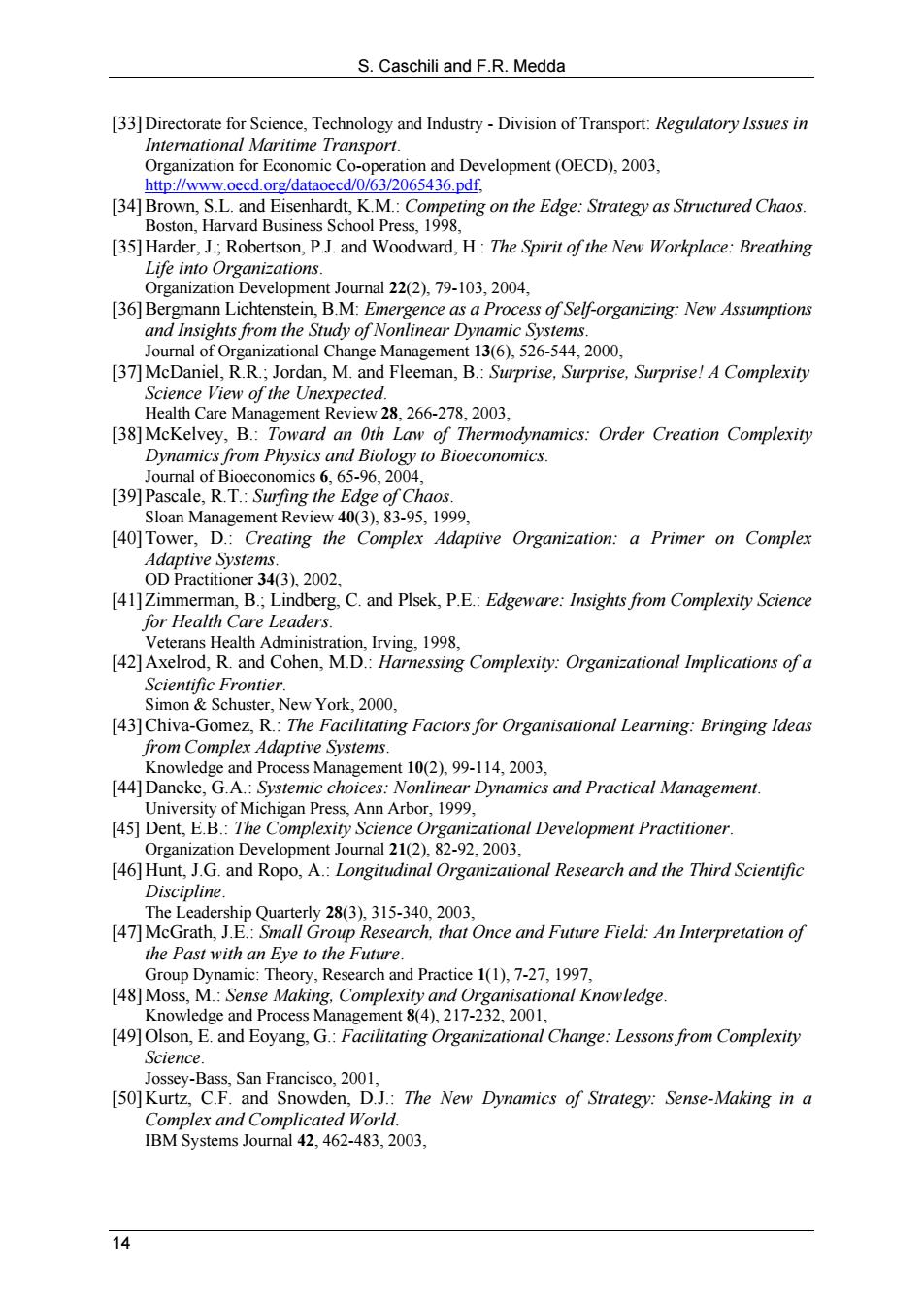正在加载图片...

S.Caschili and F.R.Medda [33]Directorate for Science,Technology and Industry-Division of Transport:Regulatory Issues in International Maritime Transport. Organization for Economic Co-operation and Development(OECD),2003 http://www.oecd.org/dataoecd/0/63/2065436.pdf, [34]Brown,S.L.and Eisenhardt,K.M.:Competing on the Edge:Strategy as Structured Chaos. Boston,Harvard Business School Press,1998, [35]Harder,J.;Robertson,P.J.and Woodward,H.:The Spirit of the New Workplace:Breathing Life into Organizations. Organization Development Journal 22(2),79-103,2004, [36]Bergmann Lichtenstein,B.M:Emergence as a Process of Self-organizing:New Assumptions and Insights from the Study of Nonlinear Dynamic Systems. Journal of Organizational Change Management 13(6),526-544,2000, [37]McDaniel,R.R.;Jordan,M.and Fleeman,B.:Surprise,Surprise,Surprise!A Complexity Science View of the Unexpected. Health Care Management Review 28,266-278,2003. [38]McKelvey,B.:Toward an Oth Law of Thermodynamics:Order Creation Complexity Dynamics from Physics and Biology to Bioeconomics. Journal of Bioeconomics 6,65-96,2004, [39]Pascale,R.T.:Surfing the Edge of Chaos Sloan Management Review 40(3),83-95,1999, [40]Tower,D.:Creating the Complex Adaptive Organization:a Primer on Complex Adaptive Systems. OD Practitioner 34(3),2002, [41]Zimmerman,B.;Lindberg,C.and Plsek,P.E.:Edgeware:Insights from Complexity Science for Health Care Leaders. Veterans Health Administration,Irving,1998, [42]Axelrod,R.and Cohen,M.D.:Harnessing Complexity:Organizational Implications of a Scientific Frontier. Simon Schuster,New York,2000, [43]Chiva-Gomez,R.:The Facilitating Factors for Organisational Learning:Bringing Ideas from Complex Adaptive Systems. Knowledge and Process Management 10(2),99-114,2003, [44]Daneke,G.A.:Systemic choices:Nonlinear Dynamics and Practical Management. University of Michigan Press,Ann Arbor,1999, [45]Dent,E.B.:The Complexity Science Organizational Development Practitioner. Organization Development Journal 21(2),82-92,2003, [46]Hunt,J.G.and Ropo,A.:Longitudinal Organizational Research and the Third Scientific Discipline. The Leadership Quarterly 28(3),315-340,2003, [47]McGrath,J.E.:Small Group Research,that Once and Future Field:An Interpretation of the Past with an Eye to the Future. Group Dynamic:Theory,Research and Practice 1(1),7-27,1997, [48]Moss,M.:Sense Making,Complexity and Organisational Knowledge. Knowledge and Process Management 8(4),217-232,2001, [49]Olson,E.and Eoyang,G.:Facilitating Organizational Change:Lessons from Complexity Science. Jossey-Bass,San Francisco,2001, [50]Kurtz,C.F.and Snowden,D.J.:The New Dynamics of Strategy:Sense-Making in a Complex and Complicated World. IBM Systems Journal 42,462-483,2003, 14S. Caschili and F.R. Medda 14 [33]Directorate for Science, Technology and Industry - Division of Transport: Regulatory Issues in International Maritime Transport. Organization for Economic Co-operation and Development (OECD), 2003, http://www.oecd.org/dataoecd/0/63/2065436.pdf, [34]Brown, S.L. and Eisenhardt, K.M.: Competing on the Edge: Strategy as Structured Chaos. Boston, Harvard Business School Press, 1998, [35]Harder, J.; Robertson, P.J. and Woodward, H.: The Spirit of the New Workplace: Breathing Life into Organizations. Organization Development Journal 22(2), 79-103, 2004, [36]Bergmann Lichtenstein, B.M: Emergence as a Process of Self-organizing: New Assumptions and Insights from the Study of Nonlinear Dynamic Systems. Journal of Organizational Change Management 13(6), 526-544, 2000, [37]McDaniel, R.R.; Jordan, M. and Fleeman, B.: Surprise, Surprise, Surprise! A Complexity Science View of the Unexpected. Health Care Management Review 28, 266-278, 2003, [38]McKelvey, B.: Toward an 0th Law of Thermodynamics: Order Creation Complexity Dynamics from Physics and Biology to Bioeconomics. Journal of Bioeconomics 6, 65-96, 2004, [39]Pascale, R.T.: Surfing the Edge of Chaos. Sloan Management Review 40(3), 83-95, 1999, [40]Tower, D.: Creating the Complex Adaptive Organization: a Primer on Complex Adaptive Systems. OD Practitioner 34(3), 2002, [41]Zimmerman, B.; Lindberg, C. and Plsek, P.E.: Edgeware: Insights from Complexity Science for Health Care Leaders. Veterans Health Administration, Irving, 1998, [42]Axelrod, R. and Cohen, M.D.: Harnessing Complexity: Organizational Implications of a Scientific Frontier. Simon & Schuster, New York, 2000, [43]Chiva-Gomez, R.: The Facilitating Factors for Organisational Learning: Bringing Ideas from Complex Adaptive Systems. Knowledge and Process Management 10(2), 99-114, 2003, [44]Daneke, G.A.: Systemic choices: Nonlinear Dynamics and Practical Management. University of Michigan Press, Ann Arbor, 1999, [45] Dent, E.B.: The Complexity Science Organizational Development Practitioner. Organization Development Journal 21(2), 82-92, 2003, [46]Hunt, J.G. and Ropo, A.: Longitudinal Organizational Research and the Third Scientific Discipline. The Leadership Quarterly 28(3), 315-340, 2003, [47]McGrath, J.E.: Small Group Research, that Once and Future Field: An Interpretation of the Past with an Eye to the Future. Group Dynamic: Theory, Research and Practice 1(1), 7-27, 1997, [48]Moss, M.: Sense Making, Complexity and Organisational Knowledge. Knowledge and Process Management 8(4), 217-232, 2001, [49] Olson, E. and Eoyang, G.: Facilitating Organizational Change: Lessons from Complexity Science. Jossey-Bass, San Francisco, 2001, [50]Kurtz, C.F. and Snowden, D.J.: The New Dynamics of Strategy: Sense-Making in a Complex and Complicated World. IBM Systems Journal 42, 462-483, 2003